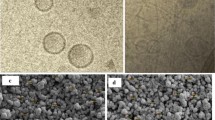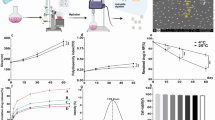Abstract
Background
In this study, the optimized niosomal formulation containing paclitaxel using non-ionic surfactants and cholesterol was designed and its cytotoxic effects against different breast cancer cell lines and apoptosis gene expression analysis were also investigated.
Methods and results
Due to enhancing equation variables, the Box–Behnken method has been applied. Lipid/drug molar ratio, the amounts of Span 60, and cholesterol were selected as the target for optimization. The particle size of niosome loaded paclitaxel and entrapment efficiency proportion have been considered in the role of dependent variables. Then the cytotoxic activity of the optimized formulation was evaluated using an MTT assay against different breast cancer cell lines including MCF-7, T-47D, SkBr3, and MDA-MB-231. The expression level of Bax and Bcl-2 apoptosis genes was determined by Real-Time PCR. In this study, the optimized niosomal formulation revealed that the synthesized niosomes had a spherical appearance and had an average size of 192.73 ± 5.50 nm so that the percentage of drug loading was 94.71 ± 1.56%. Moreover, this formulation showed a controlled and slowed release of paclitaxel at different pH (7.4, 6.5, and 5.4). The cytotoxicity results demonstrated that cell viability in all concentrations of niosome loaded paclitaxel had profound cytotoxic effects on all studied breast cancer cell lines compared to the free paclitaxel (p < 0.05). In addition, the expression of apoptosis genes was much higher than that of free paclitaxel indicating the susceptibility of cells to apoptosis.
Conclusions
As a result, niosomal formulations containing paclitaxel can be used as a new drug delivery system to increase cytotoxicity and treatment of breast cancer in the upcoming future.




Similar content being viewed by others
References
Siegel RL, Miller KD, Fuchs HE, Jemal A (2021) Cancer statistics. CA Cancer J Clin 71:33–37
Uthamacumaran A (2020) Cancer: a turbulence problem. Neoplasia 22:759–769
Ofri A, Moore K (2020) Occult breast cancer: where are we at? Breast 54:211–215
Saraswathy M, Gong S (2013) Different strategies to overcome multidrug resistance in cancer. Biotechnol Adv 31:1397–1407
Molani S, Madadi M, Williams D (2020) Investigating the effectiveness of breast cancer supplemental screening considering radiologists’ bias. medRxiv. https://doi.org/10.1101/2020.12.16.20248373
Shi C, Yang EJ, Tao S, Ren G, Mou PK, Shim JS (2021) Natural products targeting cancer cell dependency. J Antibiot (Tokyo) 74:677–686
Yang YH, Mao JW, Tan XL (2020) Research progress on the source, production, and anti-cancer mechanisms of paclitaxel. Chin J Nat Med 18:890–897
Bacanlı M, Eşi MÖ, Erdoğan H, Sarper M, Erdem O, Özkan Y (2021) Evaluation of cytotoxic and genotoxic effects of paclitaxel-loaded PLGA nanoparticles in neuroblastoma cells. Food Chem Toxicol 154:112323
Giannakakou P, Robey R, Fojo T, Blagosklonny MV (2001) Low concentrations of paclitaxel induce cell type-dependent p53, p21 and G1/G2 arrest instead of mitotic arrest: molecular determinants of paclitaxel-induced cytotoxicity. Oncogene 20:3806–3813
Farrar MC, Jacobs TF (2021) Paclitaxel. In StatPearls. Treasure Island (FL): StatPearls Publishing Copyright © 2021, StatPearls Publishing LLC
Zhao Y, Wang W, Pan W, Yu Y, Huang W, Gao J, Zhang Y, Zhang S (2021) WWOX promotes apoptosis and inhibits autophagy in paclitaxel-treated ovarian carcinoma cells. Mol Med Rep 23:1
Ansari MA, Thiruvengadam M, Farooqui Z, Rajakumar G, Sajid Jamal QM, Alzohairy MA, Almatroudi A, Alomary MN, Chung I-M, Al-Suhaimi EA (2021) Nanotechnology, in silico and endocrine-based strategy for delivering paclitaxel and miRNA: prospects for the therapeutic management of breast cancer. Semin Cancer Biol 69:109–128
Laffleur F, Keckeis V (2020) Advances in drug delivery systems: work in progress still needed? Int J Pharma 590:119912
Mitchell MJ, Billingsley MM, Haley RM, Wechsler ME, Peppas NA, Langer R (2021) Engineering precision nanoparticles for drug delivery. Nat Rev Drug Discov 20:101–124
Moghtaderi M, Mirzaie A, Zabet N, Moammeri A, Mansoori-Kermani A (2021) Enhanced antibacterial activity of Echinacea angustifolia extract against multidrug-resistant Klebsiella pneumoniae through niosome encapsulation. Nanomaterials (Basel) 11(6):1573
Bansal S, Aggarwal G, Chandel P, Harikumar S (2013) Design and development of cefdinir niosomes for oral delivery. J Pharm Bioallied Sci 5:318
Kulkarni P, Rawtani D (2019) Application of Box–Behnken design in the preparation, optimization, and in vitro evaluation of self-assembly-based tamoxifen- and doxorubicin-loaded and dual drug-loaded niosomes for combinatorial breast cancer treatment. J Pharm Sci 108:2643–2653
Kulkarni P, Rawtani D, Barot T (2019) Formulation and optimization of long acting dual niosomes using Box–Behnken experimental design method for combinative delivery of Ethionamide and D-cycloserine in Tuberculosis treatment Formulation and optimization of long acting dual niosomes using Box–Behnken experimental design method for combinative delivery of Ethionamide and D-cycloserine in Tuberculosis treatment. Colloid Surf A 565:131–142
Kulkarni P, Rawtani D, Barot T (2021) Design, development and in-vitro/in-vivo evaluation of intranasally delivered Rivastigmine and N-Acetyl Cysteine loaded bifunctional niosomes for applications in combinative treatment of Alzheimer’s disease. Eur J Pharm Biopharm 163:1–15
Kumar GP, Rajeshwarrao P (2011) Nonionic surfactant vesicular systems for effective drug delivery—an overview. Acta Pharmaceutica Sinica B 1:208–219
Sharma V, Anandhakumar S, Sasidharan M (2015) Self-degrading niosomes for encapsulation of hydrophilic and hydrophobic drugs: an efficient carrier for cancer multi-drug delivery. Mater Sci Eng C 56:393–400
Rochani AK, Balasubramanian S, Girija AR, Raveendran S, Borah A, Nagaoka Y, Nakajima Y, Maekawa T, Kumar DS (2016) Dual mode of cancer cell destruction for pancreatic cancer therapy using Hsp90 inhibitor loaded polymeric nano magnetic formulation. Int J Pharm 511:648–658
Hao Y-M (2011) Entrapment and release difference resulting from hydrogen bonding interactions in niosome. Int J Pharm 403:245–253
Baek J-S, Cho C-W (2015) Controlled release and reversal of multidrug resistance by co-encapsulation of paclitaxel and verapamil in solid lipid nanoparticles. Int J Pharm 478:617–624
Baek J-S, Cho C-W (2017) A multifunctional lipid nanoparticle for co-delivery of paclitaxel and curcumin for targeted delivery and enhanced cytotoxicity in multidrug resistant breast cancer cells. Oncotarget 8:30369
Naderi S, Alikhani MY, Karimi J, Shabab N, Mohamadi N, Jaliani HZ, Saidijam M (2015) Cytoplasmic expression, optimization and catalytic activity evaluation of recombinant mature lysostaphin as an anti-staphylococcal therapeutic in Escherichia coli. Acta Medica Inter 2:72
Patil YP, Jadhav S (2014) Novel methods for liposome preparation. Chem Phys Lipids 177:8–18
Bayindir ZS, Yuksel N (2010) Characterization of niosomes prepared with various nonionic surfactants for paclitaxel oral delivery. J Pharm Sci 99:2049–2060
Bnyan R, Khan I, Ehtezazi T, Saleem I, Gordon S, O’Neill F, Roberts M (2018) Surfactant effects on lipid-based vesicles properties. J Pharm Sci 107:1237–1246
Walker I, Gorman SA, Cox RD, Vernon DI, Griffiths J, Brown SB (2004) A comparative analysis of phenothiazinium salts for the photosensitisation of murine fibrosarcoma (RIF-1) cells in vitro. Photochem Photobiol Sci 3:653–659
Uchegbu IF, Vyas SP (1998) Non-ionic surfactant based vesicles (niosomes) in drug delivery. Inter J Pharm 172:33–70
Junyaprasert VB, Singhsa P, Suksiriworapong J, Chantasart D (2012) Physicochemical properties and skin permeation of Span 60/Tween 60 niosomes of ellagic acid. Inter J Pharm 423:303–311
Nasseri B (2005) Effect of cholesterol and temperature on the elastic properties of niosomal membranes. Inter J Pharma 300:95–101
Hedayati ChM, Abolhassani Targhi A, Shamsi F, Heidari F, Salehi Moghadam Z, Mirzaie A, Behdad R, Moghtaderi M, Akbarzadeh I (2020) Niosome-encapsulated tobramycin reduced antibiotic resistance and enhanced antibacterial activity against multidrug-resistant clinical strains of Pseudomonas aeruginosa. J Biomed Mater Res A 109(6):966–980
Bayindir ZS, Yuksel N (2010) Characterization of niosomes prepared with various nonionic surfactants for paclitaxel oral delivery. J Pharm Sci 99(4):2049–2060
Heidari F, Akbarzadeh I, Nourouzian D, Mirzaie A, Bakhshandeh H (2020) Optimization and characterization of tannic acid loaded niosomes for enhanced antibacterial and anti-biofilm activities. Adv Powder Technol 31:4768–4781
Mirzaie A, Peirovi N, Akbarzadeh I, Moghtaderi M, Heidari F, Yeganeh FE, Noorbazargan H, Mirzazadeh S, Bakhtiari R (2020) Preparation and optimization of ciprofloxacin encapsulated niosomes: a new approach for enhanced antibacterial activity, biofilm inhibition and reduced antibiotic resistance in ciprofloxacin-resistant methicillin-resistance Staphylococcus aureus. Bioorg Chem 103:104231
Shaker DS, Shaker MA, Hanafy MS (2015) Cellular uptake, cytotoxicity and in-vivo evaluation of Tamoxifen citrate loaded niosomes. Int J Pharm 493:285–294
Zare-Zardini H, Alemi A, Taheri-Kafrani A, Hosseini SA et al (2020) Assessment of a new Ginsenoside Rh2 nanoniosomal formulation for enhanced antitumor efficacy on prostate cancer: an in vitro study. Drug Des Devel Ther 14:3315–3324
Targhi AA, Moammeri A, Jamshidifar E, Abbaspour K, Sadeghi S, Lamakani L, Akbarzadeh IJBC (2021) Synergistic effect of curcumin-Cu and curcumin-Ag nanoparticle loaded niosome: Enhanced antibacterial and anti-biofilm activities. Bioorg Chem 115:105116
Sadeghi S, Bakhshandeh H, Cohan RA, Peirovi A, Ehsani P, Norouzian D (2019) Synergistic anti-Staphylococcal activity of niosomal recombinant lysostaphin-LL-37. Int J Nanomed 14:9777
Sadeghi S, Ehsani P, Cohan RA, Sardari S, Akbarzadeh I, Bakhshandeh H, Norouzian D (2020) Design and physicochemical characterization of lysozyme loaded niosomal formulations as a new controlled delivery system. Pharma Chem J 53:921–930
Mathiowitz E (1999) Encyclopedia of controlled drug delivery. Wiley, Hoboken
Ritger PL, Peppas NA (1987) A simple equation for description of solute release. II. Fickian and anomalous release from swellable devices. J Controlled Release 5:37–42
Moghtaderi M, Mirzaie A, Zabet N, Moammeri A, Mansoori-Kermani A, Akbarzadeh I, Eshrati Yeganeh F, Chitgarzadeh A, Bagheri Kashtali A, Ren QJN (2021) Enhanced antibacterial activity of Echinacea angustifolia extract against multidrug-resistant Klebsiella pneumoniae through niosome encapsulation. Nanomaterials 2021(11):1573
Dash S, Murthy PN, Nath L, Chowdhury P (2010) Kinetic modeling on drug release from controlled drug delivery systems. Acta Pol Pharm 67:217–223
Hemati H, Haghiralsadat F et al (2019) Development and characterization of a novel cationic PEGylated niosome-encapsulated forms of doxorubicin, quercetin and siRNA for the treatment of cancer by using combination therapy. Artif Cells Nanomed Biotechnol 47(1):1295–1311
Balasubramaniam A, Anil Kumar V, Sadasivan Pillai K (2002) Formulation and in vivo evaluation of niosome-encapsulated daunorubicin hydrochloride. Drug Dev Ind Pharm 28:1181–1193
Jamshidifar E, Eshrati Yeganeh F, Shayan M, Tavakkoli Yaraki M, Bourbour M, Moammeri A, Akbarzadeh I, Noorbazargan H, Hossein-Khannazer N (2021) Super magnetic niosomal nanocarrier as a new approach for treatment of breast cancer: a case study on SK-BR-3 and MDA-MB-231 cell lines. Int J Mol Sci 22:7948
Lawrence M, Chauhan S, Lawrence S, Barlow D (1996) The formation, characterization and stability of non-ionic surfactant vesicles. STP Pharma Sci 6:49–60
Seras-Cansell M, Ollivon M, Lesieur S (1996) Generation of non-ionic monoalkyl amphiphile-cholesterol vesicles: evidence of membrane impermeability to octyl glucoside. STP Pharma Sci 6:12–20
Pardakhty A, Moazeni E, Varshosaz J, Hajhashemi V, Najafabadi AR (2011) Pharmacokinetic study of niosome-loaded insulin in diabetic rats. Daru 19:404
Esfahani MKM, Alavi SE, Akbarzadeh A, Ghassemi S, Saffari Z, Farahnak M, Chiani M (2014) Pegylation of nanoliposomal paclitaxel enhances its efficacy in breast cancer. Trop J Pharma Res 13:1195–1198
Zhang G-J, Kimijima I, Onda M, Kanno M, Sato H, Watanabe T, Tsuchiya A, Abe R, Takenoshita S (1999) Tamoxifen-induced apoptosis in breast cancer cells relates to down-regulation of bcl-2, but not bax and bcl-XL, without alteration of p53 protein levels. Clin Cancer Res 5:2971–2977
Strobel T, Swanson L, Korsmeyer S, Cannistra SA (1996) BAX enhances paclitaxel-induced apoptosis through a p53-independent pathway. Proc Natl Acad Sci USA 93:14094–14099
Dabbagh Moghaddam F, Akbarzadeh I, Marzbankia E (2021) Delivery of melittin-loaded niosomes for breast cancer treatment: an in vitro and in vivo evaluation of anti-cancer effect. Cancer Nanotechnol. https://doi.org/10.1186/s12645-021-00085-9
Acknowledgements
The authors of this article thank the Islamic Azad University for its financial assistance.
Author information
Authors and Affiliations
Contributions
AM designed the experimental study, revision, and supervision, SHR performed the experimental tests, RK the gene expression analysis. BP and FT wrote the manuscript and performed cell culture. FM, FB and SHR assisted in characterization tests. SF, FH and KS assisted in data analysis.
Corresponding author
Ethics declarations
Conflict of interest
The authors declare that they have no conflict of interest.
Research involving human rights
There are no “human subjects” in this study.
Additional information
Publisher's Note
Springer Nature remains neutral with regard to jurisdictional claims in published maps and institutional affiliations.
Supplementary Information
Below is the link to the electronic supplementary material.
Rights and permissions
About this article
Cite this article
Pourmoghadasiyan, B., Tavakkoli, F., Beram, F.M. et al. Nanosized paclitaxel-loaded niosomes: formulation, in vitro cytotoxicity, and apoptosis gene expression in breast cancer cell lines. Mol Biol Rep 49, 3597–3608 (2022). https://doi.org/10.1007/s11033-022-07199-2
Received:
Accepted:
Published:
Issue Date:
DOI: https://doi.org/10.1007/s11033-022-07199-2




